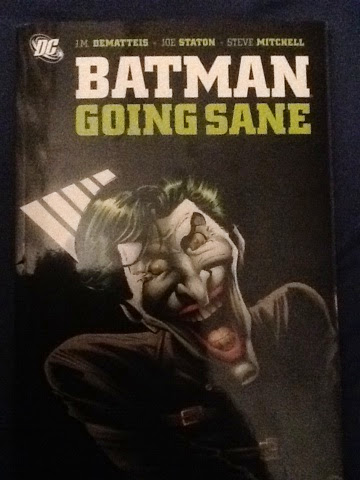Opening with a blow by blow recount of the final confrontation between Batman and 'Holiday', Tim Sale's artwork gets off to a strong start as we see Alberto Falcone beaten and arrested. The story then flashes to the present, where Falcone is in a cell in Arkham Asylum being interviewed by the new DA Janice Porter. Porter mentions reopening the Holiday case later on, to Jim Gordon. She is a character who seems shrouded in mystery, her motives not becoming that clear until a bit later into the story.
The next scene sees a graveyard vigil for Carmine Falcone, who was gunned down by Dent/Two Face at the end of TLH. Both Batman and Catwoman soon make their presence known, in a throwback to TLH where they crossed paths several times in connection with the Falcone family.
It seems that Sofia Falcone is trying to rebuild her fathers empire after his tragic death, and on the surface it seems that she is bringing the different crime families together. She hires the sons of Sal Maroni - who are introduced in a panel which is an excellent example of foreshadowing from the writer/artist team of Loeb and Sale. Tony Zucco is also involved in this 'rebuild' - a name which hints at what is to come later on in the volume if you know anything about your Bat-history.
Then, in quick succession there is a mass breakout from Arkham, and the first victim of The Hangman is discovered. All of the pieces are in place, in what slowly reveals itself to be a game that is being played for control of Gotham City.
The motif of games is most obvious in the game of hangman which is left at each of the crime scenes. Each one seems to be a clue of some sort, with the main finger of blame being pointed at Harvey Dent due to the nature of the paper which is used to write the notes. I remember when I first read The Dark Victory, I would try and figure out the significance of these notes. That's what makes this such a great Batman story - it makes the reader want to try and solved the mystery alongside Batman. And this is a mystery which isn't short of possible culprits and motives.
There is also the game being played by the escapees from Arkham, under the guidance of Two Face. A series of seemingly random events involving rogues such as Scarecrow and Solomon Grundy eventually transpire to be part of a bigger plan being masterminded by Dent. It is this game which reveals the significance of the title - The Dark Victory. Even though the various crime families have been decimated by the end of the volume, it is not without a price. Gotham belongs to the 'freaks' now.
Duality and the mirror image is also a motif that Loeb and Sale explore. Right from the opening sequence, where we see Holiday in a cell opposite Calendar Man, the idea of characters mirroring each other is present throughout.
After his parents die tragically at Haly's Circus, we see a series of panels in Wayne Manor which explore the parallels between Grayson and Wayne as they deal with the deaths of their parents in similar ways. We also see the way that Alfred deals with them both, and in a touching ending to this sequence we see that he has learnt from the mistakes he made in dealing with Bruce after the deaths of Thomas and Martha.
There are also the parallels between Sofia and her father Carmine. The most obvious is in the cat scratch scars on the side of her face. We often see panels with these scars in close up, or with Sofia gazing into a mirror, and later on we discover that they hold more significance than they first seem to. Sofia also mirrors her father in her objection to the 'freaks' who have begun to take control of Gotham. Although she never goes as far as hiring these 'freaks' to serve her purposes, unlike her father.
Dent is also a dark inversion of what he used to be before the acid destroyed his face and his psyche. Despite his methods having changed, he is still working tirelessly to rid Gotham of the organised crime which was his mission in TLH. His relationship with Porter also plays into the idea of duality, and several characters are not what they initially appear to be.
One of the other reveals of duality is that Umberto and Pino Maroni are twins, and in fact working for Two Face. This is hinted at in the panel I mentioned earlier - when their faces are half obscured in shadow, in a nod to the foreshadowing of what Dent would become in TLH.
When the dust settles on the story, several things have changed. The crime families are no longer in control of Gotham. The police force is seemingly no longer as corrupt, or at least Jim Gordon has some people in the force whom he can trust. And finally Batman is no longer alone - he has Robin.
The Dark Victory was outstanding, and Loeb and Sale have crafted the definitive Batman story here. It has everything that is great about the character. Obviously, there are other fantastic interpretations of the character, but Loeb is not a creator who can be overlooked when it comes to a list of writers who have defined the Batman we all know and love.
Next up - Robin Year One










